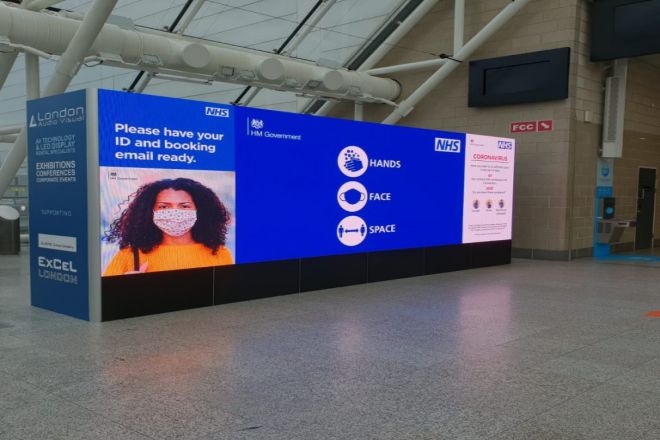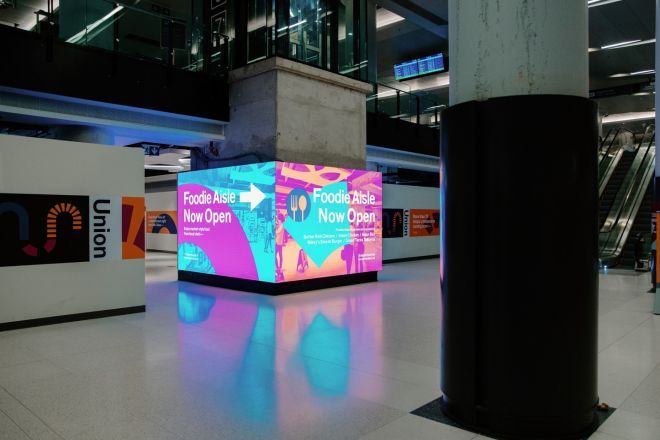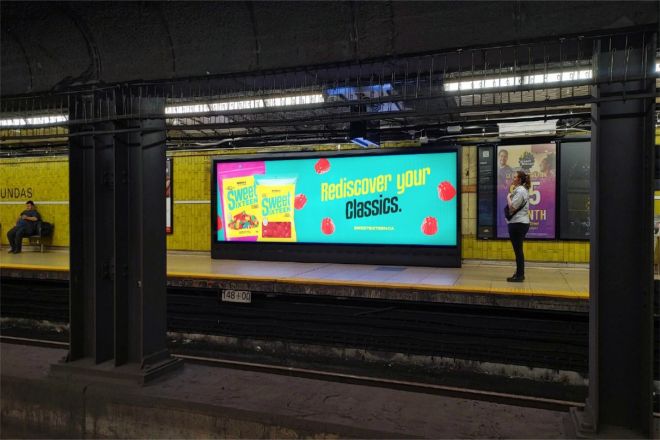مقدمة

In the fast-paced modern urban life, subway stations, as an important part of urban public transportation, are not only key nodes for people’s daily travel but also important platforms for information dissemination and cultural exchange.
فيما بينها، شاشات عرض LED, with their high brightness, high definition, and rich colors, undertake multiple functions in subway stations, such as transmitting real-time information, displaying urban features, and promoting public service advertisements, and become an indispensable visual focus in subway stations. However, with the continuous increase in passenger flow and the complexity of the social environment, subway station LED display screens are also facing the risk of being deliberately destroyed or accidentally damaged.
This not only affects the normal operation order of subway stations but also damages public property and causes inconvenience to passengers’ travel experience. Therefore, how to effectively protect the LED display screen in subway stations from being damaged has become an urgent problem that needs to be solved.
1. Understand the fragility of LED display screens
- Physical structure characteristics
As a high-tech display device, the physical structure of LED display screens is both complex and delicate. It is mainly composed of LED lamp beads, driver circuit boards, heat dissipation systems, housings, and protective screens.
As a light-emitting element, LED lamp beads have a certain impact resistance, but the screen surface is often covered with a layer of transparent protective material. Although this layer of material can prevent direct contact with the lamp beads, it is also fragile and easily scratched or hit by sharp objects, causing rupture.
In addition, the driver circuit board is a key component that controls the on and off of LED lamp beads. Its internal circuit is extremely precise and sensitive to environmental factors such as static electricity and humidity. Once damaged, it will directly affect the normal operation of the display.
- Impact of environmental factors
The impact of the external environment on the LED display cannot be ignored. First, excessive humidity will cause the internal circuit board of the display to become damp, which will cause short circuits or corrosion, seriously affecting its performance and life.
Secondly, temperature changes are also a major challenge. The luminous efficiency of LED lamp beads will decrease in high-temperature environments, and long-term high-temperature operation will accelerate their aging, while low temperatures may cause the display to be difficult to start or display abnormalities. Dust accumulation is also a common problem.
Dust particles in the air will adhere to the surface of the display and the internal heat dissipation system, which will not only affect the display effect but also hinder heat dissipation, causing the display to overheat and be damaged.
- Human factors
Human factors are one of the main causes of damage to LED displays. In public places such as subway stations, where there is a large flow of people and complex personnel, the negligence or deliberate destruction of passengers may cause damage to the display screen.
For example, passengers may accidentally collide with the display screen due to their luggage or backpacks; employees may damage the display screen due to improper operation during cleaning or maintenance; even worse, malicious vandals may deliberately use sharp tools to scratch or hit the display screen to vent their dissatisfaction or create chaos.
These behaviors not only directly damage public property but also seriously affect the normal operation order of the subway station and the travel experience of passengers.
2. Prevention strategy: physical protection
- Installation location and layout
In subway stations, rationally planning the installation location of LED display screens is the first step to prevent them from being damaged. Display screens should be avoided in areas with particularly dense and mobile traffic, such as entrances and exits, stairways, etc., to reduce the risk of accidental collisions by passengers.
At the same time, the field of view and light conditions of the display screen should be taken into account to ensure that it can clearly display information at the installation location without causing visual obstructions or reflections due to angle problems.
In addition, according to the layout characteristics of the subway station, the display screen can be installed in an area with a certain buffer space or isolation zone to further reduce the possibility of damage.
- Protective measures
In order to effectively prevent the LED display from direct impact and damage, appropriate physical barriers should be used for protection. A common practice is to install a protective cover or tempered glass in front of the display.
The protective cover should have sufficient strength and toughness to withstand a certain degree of impact and scratches; at the same time, its design should take into account the need for ventilation and heat dissipation to avoid affecting the normal operation of the display. Tempered glass is known for its high hardness and impact resistance and can effectively prevent scratches and impacts from sharp objects.
When selecting protective materials, their light transmittance, aesthetics, and coordination with the overall decoration style of the subway station should also be considered.
- التفتيش والصيانة الدورية
Regular inspection and maintenance are key links to ensure the long-term and stable operation of LED display screens. A regular inspection system should be established to conduct a comprehensive inspection of the display screen’s fixtures, protective facilities, and internal circuits.
Focus on whether the display screen’s fixtures are firm and reliable to avoid safety hazards caused by loosening or falling off; at the same time, check whether the protective facilities are intact and replace damaged or aging parts in a timely manner. In addition, the display screen needs to be cleaned and maintained to remove dust and dirt on the surface and maintain its good display effect and heat dissipation performance.
Problems found during the inspection process should be recorded and reported in a timely manner to ensure that the display screen is always in good working condition.
3. Prevention strategy: technical protection

- Intelligent monitoring system
In the protection of subway station LED display screens, intelligent monitoring systems play a vital role. By deploying high-definition cameras and intelligent image recognition technology, real-time monitoring of the area around the display screen can be achieved.
These systems can automatically identify abnormal behaviors, such as gathering of people, wandering, violent destruction, etc., and issue early warning signals at the first time. This not only helps to detect and stop potential sabotage in a timely manner but also provides strong support for subsequent investigation and evidence collection.
In addition, the intelligent monitoring system can also be linked with the security management system of the subway station to form a full-scale, multi-level protection network.
- Content security solution
In addition to physical protection, content security is also an important part that cannot be ignored. In order to prevent sabotage incidents caused by disputes over the content of the display screen, AI technology based on image recognition and natural language understanding can be used to automatically detect and filter bad content.
These technologies can analyze the images and text information on the display screen, identify content that may cause controversy or dissatisfaction, and automatically block or replace it.
At the same time, a content review mechanism can also be established to manually review and check the information displayed on the display screen to ensure that its content is healthy, positive, and in line with social morality and legal and regulatory requirements.
- Remote monitoring and control
In order to further improve the protection efficiency and response speed of the LED display screen, a centralized operation and maintenance management platform can be established to achieve remote monitoring and control.
Through this platform, operation and maintenance personnel can view the operating status, playback content, and surrounding environment of the display screen in real-time and remotely control it as needed. Once an abnormal situation is found or an early warning signal is received, the operation and maintenance personnel can immediately take measures to intervene and deal with it, thereby effectively reducing the risk of damage on site.
In addition, remote monitoring and control can also reduce operation and maintenance costs and improve work efficiency, providing strong support for the intelligent management of subway stations.
4. Prevention strategy: management and system
- Formulate rules and regulations.
In order to ensure the safety and normal operation of the LED display screen at the subway station, the first task is to formulate clear rules and regulations. These rules and regulations should specify in detail the use specifications, maintenance requirements, and prohibited behaviors of the LED display screen.
In particular, it is necessary to clearly prohibit any form of destructive behavior, including but not limited to intentional damage, alteration, blocking of the display screen, and stipulate corresponding penalties. At the same time, the rules and regulations should also clarify the responsible parties, including subway station management, staff, and passengers, to ensure that all parties can clearly understand their responsibilities and obligations.
Through the formulation and implementation of rules and regulations, an effective constraint mechanism can be formed to reduce the risk of LED display screens being damaged.
- Strengthen employee training
Employees are an important force in the daily operation of subway stations and a key link in protecting LED display screens. Therefore, it is crucial to strengthen employee training. The training content should include basic knowledge of LED display screens, maintenance skills, safe operating procedures, and the ability to respond to emergencies.
Through training, employees can be more familiar with the structure and performance characteristics of the display screen and master the correct maintenance methods and techniques; at the same time, it can also improve employees’ safety awareness and sense of responsibility so that they can pay more attention to the safety of the display screen in their daily work, and promptly discover and report potential safety hazards.
In addition, employees can be organized to conduct emergency drills and simulation training regularly to improve their ability and level to respond to emergencies.
- Public publicity and education
Public publicity and education are effective ways to raise public awareness of protecting public property. Subway stations can publicize the importance of protecting LED display screens to passengers through various channels and methods.
For example, subway broadcasts, bulletin boards, posters, and other media can be used to convey the concept and requirements of protecting public property to passengers; at the same time, propaganda panels or videos can be set up in subway stations to enhance the propaganda effect.
In addition, the public can be guided to pay attention to the issue of public property protection and improve their sense of responsibility and participation through thematic activities, lectures, or workshops.
Through public publicity and education, a good atmosphere of common concern and participation in protecting public property can be formed.
5. Response and recovery measures

- Emergency response mechanism
In the face of possible damage to LED display screens, it is crucial to establish an emergency response mechanism. This mechanism should clearly define the action steps to be taken as soon as the display screen is damaged, including immediately launching an emergency plan, notifying relevant departments and personnel, assessing the extent of damage, and preliminarily judging the repair time.
At the same time, sufficient spare resources, such as technicians, maintenance tools, and equipment, should be ensured to respond quickly and carry out repair work. In addition, a cooperative relationship with a third-party maintenance service provider should be established so that professional support can be obtained quickly when necessary.
Through an efficient emergency response mechanism, the impact of display screen damage on subway station operations and passenger travel can be minimized.
- Backup and recovery strategy
In order to ensure that the display content can be quickly restored when the display is damaged, it is essential to develop a display content backup plan. This plan should include regular backup of all content on display and storage in a safe and reliable location.
At the same time, a quick recovery process should be established so that the backup content can be quickly restored to the spare display or the repaired display when the display is damaged.
In addition, advanced technologies such as cloud storage can also be considered to enhance the reliability and accessibility of backup data. By implementing a backup and recovery strategy, the continuity and integrity of the display content can be ensured, and the smooth transmission of information can be guaranteed.
- Repair and upgrade
Repair work for damaged LED displays should be carried out in a timely manner. During the repair process, the cause of damage and the degree of damage should be carefully analyzed and targeted repair measures should be taken. At the same time, necessary upgrades should be considered during the repair process to enhance the display’s ability to resist damage.
For example, stronger protective materials can be replaced, the protection design of internal circuits can be strengthened, and the heat dissipation system can be optimized. In addition, new technologies and functions such as intelligent monitoring and automatic alarms can also be considered to further enhance the safety and reliability of the display.
Through timely repairs and necessary upgrades, it can be ensured that the LED display screen can better serve the operation of the subway station and the travel needs of passengers after restoration.
خاتمة
In summary, protecting the LED display screen of the subway station from damage is a systematic and complex process, which requires careful consideration of physical protection, technical protection, management and system, and response and recovery measures.
By implementing these strategies and methods, we can effectively reduce the risk of damage to the LED display screen, ensure its normal and stable operation, and provide passengers with a more convenient, comfortable, and safe travel environment. At the same time, we should also realize that protecting public property is everyone’s responsibility and obligation. Only with the joint efforts of the whole society can we create a more harmonious and beautiful urban life.
وأخيرًا، إذا كنت تريد معرفة المزيد عن شاشات العرض LED، يرجى الحصول على اتصال معنا.
